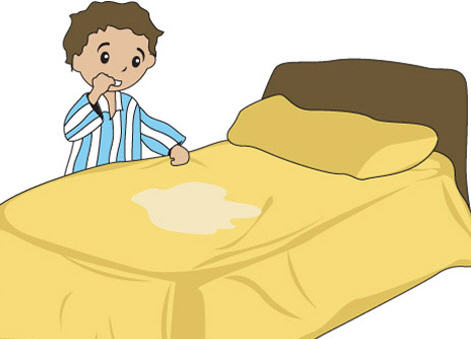Step-by-Step Approach for Bed Wetters
By Dr. Bill Sears
 AROUND 15 PERCENT of 5-year-olds still wet their beds, and boys outnumber girls four to one. As a pediatrician for more than 40 years, I want to dispel the myth that bed-wetting is a psychological or discipline problem.
AROUND 15 PERCENT of 5-year-olds still wet their beds, and boys outnumber girls four to one. As a pediatrician for more than 40 years, I want to dispel the myth that bed-wetting is a psychological or discipline problem.
Instead, it’s really a sleep quirk. It’s physiologically more correct to call this nighttime nuisance “sleep wetting.” Some kids sleep too soundly to respond to the get-up-and-go signals from their bladder. Here is a step-by-step approach that we’ve used in our family and in my pediatric practice.
Play show and tell. In my of office I draw a picture of the brain with “wires” connected to the bladder, explaining to the child, “Your bladder is like a balloon the size of a baseball. Inside the balloon are tiny nerves that tell you when your bladder is full. Your full bladder then sends messages to your brain, and the brain tells you to go pee. Because you sleep so deeply, the brain sort of says, ‘Don’t bother me. I’m sleeping.’ Yet, your bladder becomes so full it’s got to empty, so you pee in your bed. Here’s how we’re going to help your brain and your bladder listen to each other at night.”
Empty the bladder completely before going to bed. Many bed-wetters who are tired or in a hurry only dribble out a bit when they go to the bathroom before going to bed, so they go to sleep with a half-full bladder. Teach your child “triple voiding”: “To squeeze all the pee out of your bladder, grunt, grunt, grunt three times so you go to bed with an empty bladder.”
Have a bladder-programming talk. Be a bladder-training coach: As your child is dozing off to sleep, imprint on his mind what he will do when he feels a full bladder: “I will get up and go to the bathroom when I feel my bladder get big. I will splash water on my face to wake up, and grunt three times.” This bedtime rehearsal programs your child to help his bladder and brain cooperate at night.
Shake and wake before you retire. Since most children bed-wet within a few hours after retiring, before you go to bed, fully awaken your child and help him walk to the bathroom and again “grunt three times” to completely empty his bladder. Then help the sleepy child get back to bed.
Get things moving. Since constipation is a frequently overlooked cause of bed-wetting, give your child a tasty laxative: a fruit and yogurt smoothie with a tablespoon of flax oil.
Give high-tech help for the persistent bed-wetter. If your child is becoming increasingly wet and bothered, try a pad-and-buzzer apparatus called a bladder-conditioning device. When a drop of urine strikes the moisture-sensitive pad, it sets off a buzzer that’s attached to the child’s T-shirt or pajama top. Explain this to your child as the “beat the buzzer” game. Encourage him to get up and go to the bathroom before the buzzer sounds.
In my pediatric practice experience, more than 90 percent of bed-wetters become dry after trying these strategies. A patient of mine thanked me, “Dr. Bill, being dry makes me feel so happy. Now I can stay overnight at a friend’s house without feeling embarrassed.”
Source: CostcoConnection

